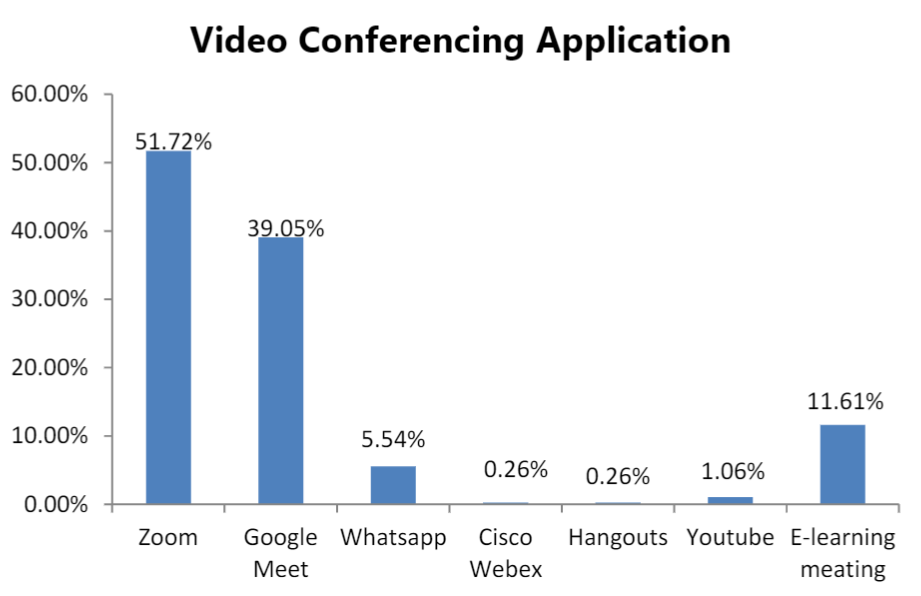Students’ Perspective and Attitude towards Distance Learning Using Video Conferencing Learning Platform during Covid-19 Pandemic in Indonesia
Main Article Content
บทคัดย่อ
The Coronavirus disease outbreak has caused the global panic that affected to the limitation of human activities, including teaching and learning process in schools. Since Indonesia government supported on Work from home (WFH) campaign, majority of schools emphasized distance learning by using video conferencing to conduct teaching and learning activity. Video conferencing technology is considered as an advantageous media for teaching and learning activities because of its ability to bring the classroom environment into digital form. This study has an objective to identify the quality of teaching and learning process using video conferencing platform based on students’ perspective and attitude. The sample of this study is 379 respondents from the junior and senior high schools students in Indonesia. The data collection is conducted using questionnaire based on students’ perception and attitude towards the use of video conferencing during covid-19 pandemic. The result is divided into two variables which are students’ perspective and attitude. Students’ perspective result shows positive response to the use of video conferencing in learning such as providing joyful learning, easiness to access learning activity, and easiness in completing a learning task. Furthermore, the result reveals that the video conferencing for learning is lacked in providing better understanding, and active and collaborative learning. Majority of the students faced technical issues as obstacles.
Article Details
เอกสารอ้างอิง
Bhasin, B. (2012). Integration of Information and Communication Technologies in Enhancing Teaching and Learning. Journal Contemporary Educational Technology, 3(2), 130-140. https://doi.org/10.30935/cedtech/6073
Buselic, M. (2012). Distance Learning – Concepts and Contributions. Oeconomica Jadertina, 2(1), 23-34. https://doi.org/10.15291/oec.209
Caladine,R.(1999).TeachingforFlexibleLearning:LearningtoApplytheTechnology.GSSE:Monmouthshire
Candarli, D., and Yuksel, H. G. (2012). Students’ perceptions of video-conferencing in the classrooms in higher education. Procedia-Social and Behavioral Sciences, 47, 357-361. https://doi.org/10.1016/j.sbspro.2012.06.663
Cochrane, C. (1996). The use of videoconferencing to support learning: an overview of issues relevant to the library and information profession. Education for Information, 14(4), 317-330.
Davis, F. D., Bagozzi, R. P., and Warshaw, P. R. (1989). User acceptance of computer technology: a comparison of two theoretical models. Management science, 35(8), 982-1003. https://doi.org/10.1287/mnsc.35.8.982
Denstadli, J. M., Julsrud, T. E., and Hjorthol, R. J. (2012). Video-conferencing as a mode of communication: A comparative study of the use of videoconferencing and face-to-face meetings. Journal of Business and Technical Communication,26(1),65-91. https://doi.org/10.1177/1050651911421125
Drexhage, J., Leiss, D., Schmidt, T., and Ehmke, T. (2016). The connected classroom: Using video conferencing technology to enhance teacher training. Reflecting Education, 10(1), 70-88.
Freeman, M. (1998). Video Conferencing: A Solution to The Multi-Campus Large Classes Problem?. British Journal of Educational Technology, 29(3), 197-210. https://doi.org/10.1111/1467-8535.00064
Gladović, P., Deretić, N., and Drašković, D. (2020).Video Conferencing and its Application in Education.JTTTP-Journal of Traffic and Transport Theory and Practice, 5(1). https://doi.org/10.7251/JTTTP2001045G
Ismawati, D. and Prasetyo, I. (2021). Efektivitas Pembelajaran Menggunakan Video Zoom Cloud Meeting pada Anak Usia Dini Era Pandemi Covid-19. Jurnal Obsesi: Jurnal Pendidikan Anak Usia Dini, 5(1), 665-675. https://doi.org/10.31004/obsesi.v5i1.671
Jamal, S. (2020). Analisis Kesiapan Pembelajaran E-Learning Saat Pandemi Covid-19 Di SMK Negeri 1 Tambelangan, Jurnal Nalar Pendidikan, 8(1), 16-22. https://doi.org/10.26858/jnp.v8i1.13561
Laurillard, D. (1993). Rethinking University Teaching: A Framework for Effective Use of Educational Technology. London: Routledge.
MacLaughlin, E. J. Supernaw, R. B. and Howard, K. A. Impact of Distance Learning Using Videoconferencing Technology on Student Performance. American Journal of Pharmaceutical Education, 68(3), 1-6. https://doi.org/10.5688/aj680358
Mahdum, M., Hadriana, H., and Safriyanti, M. (2019). Exploring Teacher Perceptions and Motivations to ICT Use in Learning Activities in Indonesia. Journal of Information Technology Education, 18, 293-317.
Mitchell,J.(1993).Video-ConferencinginHigherEducationinAustralia:AnEvaluationoftheUseandPotentialofVideo-ConferencingFacilitiesintheHigherEducationSectorinAustralia.OccasionalPapersSeriesDEETHigherEducationDivision.AGPS: Canberra.
Mustakim. (2020). Efektivitas Pembelajaran Daring Menggunakan Media Online Selama Pandemi Covid-19 Pada Mata Pelajaran Matematika. Al asma: Journal of Islamic Education, 2(1), 1-12.
Muthmainnah, S., Johan, R. C., and Riyana, C. (2019). Hubungan Antara Pembelajaran Menggunakan Kelas Maya dengan Kemandirian Belajar Mahasiswa. Jurnal Edu Technologia, 3(1), 30-40.
Robert, R. (2009). Video conferencing in distance learning: A New Zealand schools’ perspective. Journal of Open, Flexible, and Distance Learning, 13(1), 91-107.
King, J., and South, J. (2017). Reimagining the role of technology in higher education: A supplement to the national education technology plan [Electronic version]. US Department of Education, Office of Educational Technology.
Suryani, A. (2010). ICT in education: Its benefits, difficulties, and organizational development issues. Jurnal Sosial Humaniora (JSH), 3(1), 13-33. https://doi.org/10.12962/j24433527.v3i1.651
Tavakol, M., and Dennick, R. (2011) Making sense of Cronbach alpha, Int. Journal Med. Education, 2(1), 53-55.
Traxler, J. (2018). Distance learning: Predictions and possibilities. Education Sciences, 8(1), 35. https://doi.org/10.3390/educsci8010035


